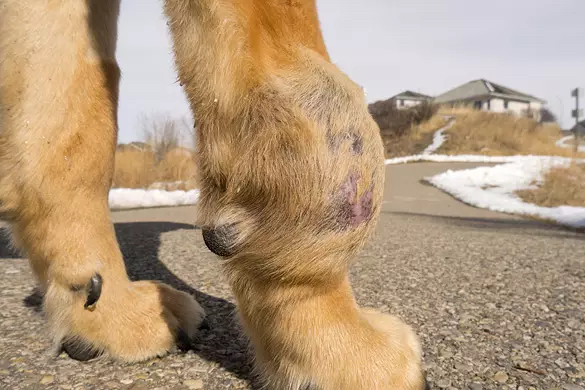Cancers are a common cause for lameness in dogs. There are many different types of tumors including skin and subcutaneous tissues. It is important that if you notice your dog is not using a limb normally that you seek veterinary care, especially if it does not fully resolve quickly.
A lameness diagnosis starts with taking a complete history of the problem, lifestyle of your pet, and anything you have tried to help (rest, heating pad, worsening or improvement). After getting a history your veterinarian will do a physical exam that includes evaluation of the limb that your pet isn’t using. Since there is not much soft tissue around the lower limbs if there is a tumor present it is usually visible. These lesions should be evaluated by feeling them. Tumors of the bone are painful on direct palpation, tumors of soft tissue usually cause pain due to size and invasion of surrounding tissue so there may be pain associated with movement of the joints above or below the tumor but not on direct palpation (direct palpation could be painful if the tumor surrounds a joint or nerve).
Physical exam findings should always be confirmed with appropriate testing. If there is a soft tissue mass and aspirate of the lesion can be helpful to diagnose the type of tumor and x-rays can be helpful in trying to determine if the tumor has spread to other areas. While waiting on test results pain medication can be helpful but usually will not completely control the pain associated with the tumor.
Once of the type of tumor has been determined the next steps can be discussed, this often includes some type of surgery to remove the tumor. If the tumor is small it may be possible to remove just the tumor. If the tumor is large or it involves the bone a limb amputation is typically recommended. Following surgery chemotherapy may or may not be indicated.
During recovery from surgery rehabilitation therapy could be used to help regain use of the limb or strengthen the remaining limbs if amputation is

necessary. Rehabilitation can also be a form of pain control depending on the condition, location, and type of surgery.
If we are thinking about the types of tumors that can develop in the limbs we can break it down into groups by considering the structures in the leg. Skin and subcutaneous tissues the most common ones include mast cell tumors, sarcomas, and lipomas. Subcutaneous tumors can infiltrate surrounding tissue causing pain and abnormal use of the limb, usually presenting as a lameness. Muscles can develop tumors but this is rare in dogs and there is not much literature on primary muscle tumors. Tumors of the bone cause severe lameness and pain- this can occur even before there is evidence of disease on x-rays. There are several types of tumors of the bone and synovium including osteosarcoma, chondrosarcoma, fibrosarcoma, and hemangiosarcoma. By far the most common is osteosarcoma and typically occurs in large and giant breed dogs 7-9 years old. Tumors of the joint capsule are less common but can be seen in Golden Retrievers, Labradors, and Rottweillers. These dogs usually have previous underlying joint disease that causes inflammation.
There are multiple causes for lameness and it is always important to have your pet evaluated if they are not using one of their legs normally. Even if they are still doing their daily activities and not crying out in pain.


